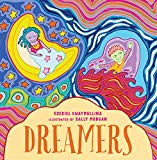This high-energy picture book celebrates the diverse possibilities that children imagine for themselves. The breadth of its scope is indicated by the dedication: 'For the children of the world'. The word text on each spread is brief, but it focuses on binary opposites, not as alternative but as complementary possibilities. 'We are the dream and the dreamers'; 'The rain jumpers and the cloud fliers'. They are not opposites in the conventional sense of books about big and small, tall and short, young and old. These are extremes of perspective. Considered one way, children are the dreamers; but they are also the dream. They jump over rain (if rain is seen as an obstacle), they jump in the rain, they jump puddles left by the rain, but switching the perspective, they also fly or manoeuvre the clouds as if the clouds were kites, they fly over and under the clouds, they fly despite clouds, they fly through the clouds. Now what do 'clouds' mean? This is how the word text works.
The spreads accumulate across the narrative as an unrhymed poem, inviting readers to explore the layers of meaning wherever they find them. The metanarrative of the concluding spreads focuses on children as the storytellers and visualisers of a reimagined world. It is dynamic, exhilarating and rainbow coloured. The word text finishes, 'We are children wild and hope bright'.
Although the design and illustration style are instantly identifiable as Sally Morgan's, and First Nations in origin, the children do not necessarily identify as Indigenous. They may have curly hair, but their skin can be green or blue. They may have dreadlocks or be carrying a traditional shoulder bag, but they are skateboarding on lightning flashes or dancing in painted jeans. It's significant that in one spread their hair is animal-shaped, and in another they are surrounded by Australian native animals. The animal heads refer both to traditional Indigenous totems and to the western fashion for playful animal hats from Japan. These spreads confirm both the non-Indigenous use of the term 'Dreamers' and the Indigenous concept of 'The Dreaming'. The layering of the narrative is remarkable, given the brevity of the words text and page extent. As with the illustrations generally, the imagery fuses Indigenous and non-Indigenous iconography. So the word and picture narrative is a joyous celebration of inclusiveness.
"Dreamers' lends itself to read-aloud, interactive performance, and adaptations in other media.
Ezekiel Kwaymullina and his mother, Sally Morgan, are descended from the Palyku people of the Pilbara region of Western Australia.

